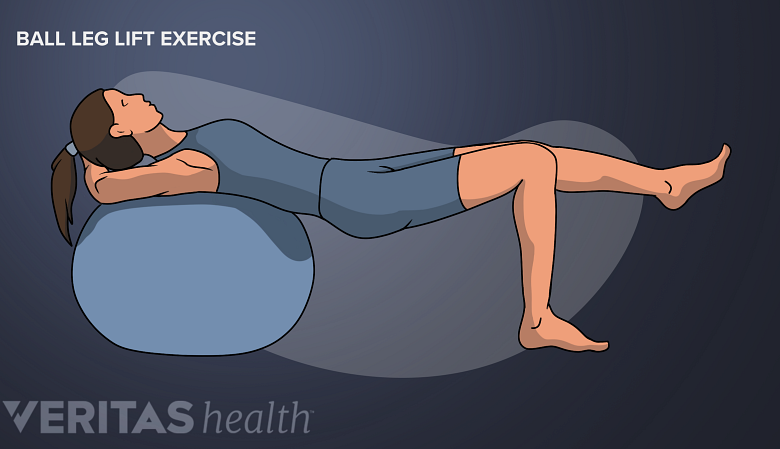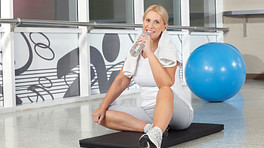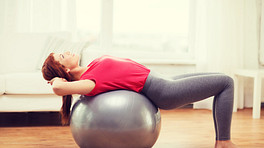The unique design of a Swiss ball engages several groups of muscles to maintain balance during use.
Whether you're simply sitting on a Swiss ball (also called an exercise ball) or using it for advanced workouts, its unstable surface forces a deep activation of the core muscles – providing an enjoyable and challenging way to improve posture, balance, and stability throughout the body. 1 Kim MK. The effects of trunk stabilization exercise using a Swiss ball in the absence of visual stimulus on balance in the elderly. J Phys Ther Sci. 2016;28(7):2144-2147. doi:10.1589/jpts.28.2144
In This Blog:
Here are 5 Swiss ball exercises ranging from easiest (for beginners) to most challenging (for advanced athletes) for you to combine into your daily workout program.
1. Easiest: 30-minute sit
Sitting on an exercise ball requires subtle yet constant engagement of the core muscles to remain balanced and centered on the ball.
To perform a 30-minute seated exercise, begin by sitting on the exercise ball with your feet flat on the ground and hip-width apart.
- Slightly tighten your abdominal muscles to engage your core and find your center of balance on the ball.
- Focus on keeping an upright posture.
Sit on the ball for 10 minutes initially, and work up to 30 minutes.
Beginners find it easier to balance on an exercise ball that’s slightly deflated.
2. Easy: Ball marching
Deepen the activation and engagement of your core muscles with the ball marching exercise.
To perform this exercise, sit on the Swiss ball with your feet flat on the ground and hip-width apart.
- With an upright spine and hands on your knees, lift one heel off the floor while keeping your toes on the ground. (To make the impact of this exercise greater, lift your whole foot off the ground.)
- Hold this position for a few seconds and bring your foot back down.
- Switch to the other side.
Repeat this exercise for 10 to 15 minutes.
3. Medium: Wall-assisted ball squat
This exercise strengthens the core muscles and teaches you how to lift objects safely with a supported posture.
To perform the wall-assisted ball squat exercise, stand with your back against a wall and place the exercise ball between your lower back and the wall.
- Position your feet slightly in front of you, shoulder-width apart.
- Place your hands on your hips and press your back firmly against the ball.
- Hinge at your hips (bend your hips as if you’re going to sit on a chair behind you) and slowly bend your knees, lowering your body into a squat position.
- While lowering into the squat position, keep your feet flat on the ground with your body weight distributed more towards your heels.
- The ball should roll upwards as you move down.
- Hold for a few seconds in the deepest part of the squat, then slowly return to standing.
Repeat the exercise 5 times.
For a more advanced exercise, increase the number of repetitions or hold for more time at the deepest part of the squat.
See Flexibility Routine for Exercise Ball
4. More challenging: Ball sit-ups
A Swiss ball makes the conventional sit-up exercise more dynamic as it requires more balance to engage and activate the abdominal muscles.
To perform the dynamic ball sit-ups, begin by sitting on the exercise ball with your feet flat on the ground and hip-width apart.
- Cross your arms over your chest and gently lean back into a 45° angle, bending at your hips and raising up on your toes.
- Hold this position for a few seconds.
- Use your abdominal muscles to pull yourself back up into a sitting position without lifting your feet.
Repeat the exercise 5 times.
For a more advanced exercise, increase the number of repetitions or hold for more time while leaning back.
5. Most challenging: Ball leg lifts
Similar to the previous exercise, the ball leg-lift exercise elevates the impact of a conventional leg-lift.
To perform ball left-lifts, sit on the floor and place the exercise ball directly behind you.
- Gently roll back so your head and shoulders are resting on the ball and the ball is positioned between your shoulder blades on your upper back area.
- Keep your hands behind your head, and place your feet flat on the ground.
- Slowly raise your torso and hips until your spine is parallel to the floor and your knees are bent at a 90° angle.
- Lift one leg off the floor and straighten it until it’s level with the rest of your body.
- Hold this position for 10 seconds, then lower the leg.
Repeat this exercise 5 times for each leg. For a more advanced exercise, increase the number of repetitions or hold for more time when the leg is extended.
Ensure you maintain steady and deep breathing during your workout session. If any exercise or movement causes sudden or sharp pain, it is advisable to stop the exercise and seek guidance from a physical therapist or a qualified healthcare provider.
- 1 Kim MK. The effects of trunk stabilization exercise using a Swiss ball in the absence of visual stimulus on balance in the elderly. J Phys Ther Sci. 2016;28(7):2144-2147. doi:10.1589/jpts.28.2144

